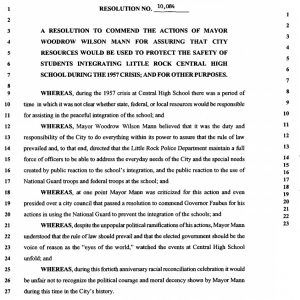calsfoundation@cals.org
Woodrow Wilson Mann (1916–2002)
Woodrow Wilson Mann Sr. served as the fifty-third mayor of Little Rock (Pulaski County) during a tumultuous two-year term that included the 1957 desegregation of Little Rock Central High School.
Woodrow Mann was born in Little Rock on November 13, 1916, to Fred Mann and Ruby Pritchard Mann. In 1934, he graduated from Little Rock High School. Growing up, he delivered ice for his father’s business and played baseball. He attended the University of Illinois on a music scholarship. While there, he played trombone in the First Regimental Band and was a member of business organizations. Also while in college, he met his future wife, Beverly Burnett, whom he married in 1938. They had two sons.
Following graduation in 1938, he moved to Chicago, Illinois, and worked in the insurance business. During World War II, he was a naval officer, serving on the staff of Admiral Chester Nimitz.
After the war, he returned home to Little Rock and worked in the insurance business. He worked in that field until his retirement in the early 1990s.
In 1955, Mann sought the office of Little Rock mayor as a Democrat. His opponent was Republican incumbent Pratt C. Remmel. Governor Orval Faubus and other local Democratic officeholders campaigned on behalf of Mann, who defeated Remmel.
Mann took office in January 1956 and began making changes. In addition to revitalizing the city’s bus system, he changed a rule at Little Rock City Hall that said black citizens had to drink out of cups to use the drinking fountain; he removed the sign that gave those instructions and put out cups for everyone. He also oversaw the dismantling of the copper dome on top of City Hall (as opposed to the repair of the dome that had been championed by Mayor Remmel) following a survey taken by an unofficial write-in postcard process asking the public to weigh in on three options: repair the dome, replace it with an aluminum facsimile, or remove it. The “remove” option received a plurality of votes, and the dome was removed.
By July 1956, Mayor Mann was caught up in a grand jury investigation into purchasing practices at City Hall. Partially in response to this, Little Rock voters approved a new form of government in November 1956 by which the city would be governed by a city manager rather than a mayor; this had been supported by local business leaders organized under the name Good Government Committee. Mayor Mann opposed this switch, which left him something of a caretaker rather than a leader, and refused to set the election for the new officials. A decision by the Arkansas Supreme Court compelled him to do so, however, and on November 5, 1957, he left office.
The last few months of Mayor Mann’s term had been filled with unrest due to the desegregation crisis at Central High School (where his older son Woody was a senior). He sought to keep the peace in various ways and to broker an arrangement between President Dwight Eisenhower and Governor Orval Faubus, although his powers within the city were no doubt hampered by his lame-duck status. Most significantly, on September 23 and 24, 1957, Mann telegrammed President Eisenhower begging for federal intervention to quell the crowds, restore order around Little Rock Central High, and protect the Little Rock Nine. In response to the telegrams, the president sent the 101st Airborne Division of the U.S. Army into Little Rock.
Though the grand jury had failed to indict him in 1956 for the charges related to purchasing practices at City Hall, factors such as the criticism leveled against him in the grand jury’s report, the switch in government structure, and the backlash against his actions during the events at Central High School left him a pariah. He explained his perspective on the 1957 Central High events in a series of articles that appeared in the New York Herald Tribune in 1958 and were syndicated. His insurance business had suffered due to his stand at Central High, however, and he no longer felt welcome in Little Rock. He received hate mail and death threats, and crosses were burned on his lawn.
In 1959, he moved to Dallas, Texas. About two years later, he relocated to Houston, where he lived the rest of his life. In 1996, he suffered a stroke. On August 6, 2002, he died due to complications from the stroke.
During the 1997 commemoration of the fortieth anniversary of the integration of Little Rock Central, the Little Rock City Board of Directors approved Resolution 10,084 to commend Mann for his actions in 1957. In addition, his official portrait was temporarily moved from the city board room to a position of honor in the rotunda of City Hall.
For additional information:
Carter, Scott Whiteley. “Little Rock Look Back: Mayor Woodrow Mann.” Little Rock Culture Vulture. https://lrculturevulture.com/2015/11/13/little-rock-look-back-mayor-woodrow-mann/ (accessed March 7, 2018).
George, Emmett. “Served as LR Mayor during Trying Period.” Arkansas Democrat-Gazette, August 8, 2002, 16B.
Jacoway, Elizabeth. Turn Away Thy Son: Little Rock, the Crisis That Shocked a Nation. New York City: Free Press, 2007.
Martin, Douglas. “Woodrow Mann Dies at 85; Sought Troops in Little Rock.” New York Times, August 9, 2002. Online at http://www.nytimes.com/2002/08/09/us/woodrow-mann-dies-at-85-sought-troops-in-little-rock.html (accessed March 7, 2018).
McLellan, Dennis. “Woodrow Mann Sr., 85; Mayor of Little Rock Sought Troops.” Los Angeles Times, August 10, 2002. Online at http://articles.latimes.com/2002/aug/10/local/me-mann10 (accessed March 7, 2018).
Pipes, Kasey S. Ike’s Final Battle: The Road to Little Rock and the Challenge of Equality. Los Angeles: World Ahead Publishing, 2007.
Scott Whiteley Carter
Little Rock, Arkansas
 Politics and Government
Politics and Government World War II through the Faubus Era, 1941 through 1967
World War II through the Faubus Era, 1941 through 1967 Mann Commendation Document
Mann Commendation Document  Woodrow Mann
Woodrow Mann 



Comments
No comments on this entry yet.